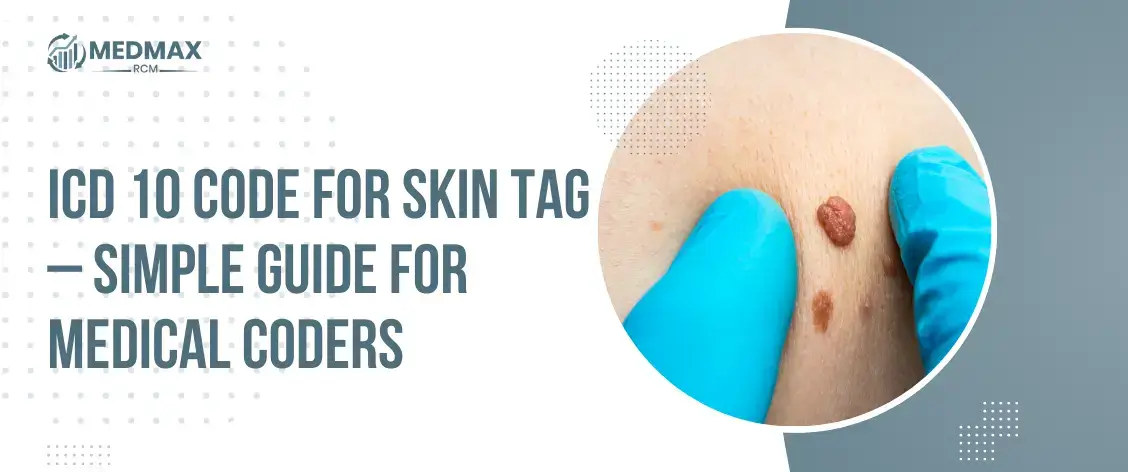
ICD 10 Code for Skin Tag – Simple Guide for Medical Coders
As acrochordons are medical terms, skin tags are harmless growths on the skin that tend to show up where skin rubs against skin, like in the thighs, armpits, and neck.
Even though they aren’t dangerous, you may need to take them off for health or style reasons. It’s important to use the right numbers so that you can pay your bills and insurance. This is a complete guide about the skin tag removal CPT codes and the problems that come up with payments.
Table of Contents
ToggleWhat Are Skin Tags?
Skin tags are small, soft, flesh-colored growths that hang off the skin. They are non-cancerous and typically painless. However, they can become irritated or bleed if subjected to friction from clothing or jewelry. In such cases, removal may be medically necessary.
ICD-10 Code for Skin Tag
The primary ICD-10 code for skin tag is, L91.8 – Other hypertrophic disorders of the skin
This code is used when skin tags cause symptoms such as irritation, bleeding, or discomfort, making their removal medically necessary.
Why Accurate ICD-10 Coding for Skin Tags Matters
Insurance companies are very strict about what is medically necessary and what is just for looks. Getting rid of skin tags for no reason is usually not covered by insurance. But you might be able to get your money back if the tag hurts, irritates, swells, or bleeds. But it has to have the right papers and an ICD-10 code for the skin tag.
If you enter the wrong code, your claims could be held up, turned down, or checked out. In busy offices, making a mistake with something as small as a skin tag might not seem important, but it costs money and takes time to fix.
Common Skin Tag ICD-10 Codes
L91.8 – Other hypertrophic disorders of the skin
This is a go-to ICD 10 Code For Skin Tag, particularly if the tag causes irritation or friction-related symptoms. It can be billed, but it needs to be backed up by notes about pain or swelling.
L98.8 – Other specified disorders of the skin and subcutaneous tissue
This becomes the more appropriate ICD 10 code for skin tags if the skin tag is red, sick, or bleeding. Once more, you’ll need proof that the surgery is physically necessary.
D23.9 – Benign neoplasm of skin, unspecified
When the exact reason or form of the tag cannot be determined, this is another valid ICD 10 for skin tags. This is a safe and billable choice if you’re not sure if it’s enlarged or irritated.
K64.4 – Residual hemorrhoidal skin tags
Use this ICD 10 code for skin tag removal on the perianal area that is left over from hemorrhoids. It is very specific, and insurance will accept it as real if it is fully recorded.
Location-Specific ICD-10 Codes for Skin Tags
Skin tags can grow almost anywhere, and their location can affect both diagnosis and reimbursement:
| Location | Recommended ICD-10 Code | Billable |
|---|---|---|
| Neck | L91.8 | Yes |
| Eyelid | D23.9 | Yes |
| Groin | L91.8 | Yes |
| Labial | L98.8 | Yes |
| Rectal/Perianal | K64.4 | Yes |
| Ear | D23.9 | Yes |
| Armpit (Axilla) | L91.8 | Yes |
Medical Necessity and Documentation
Prove That It’s Medically Necessary
There must be a medical cause for using the proper ICD 10 code for skin tag removal when submitting a claim. Insurance companies only cover skin tags that disturb or threaten your health. Itting, bleeding, constant rubbing against garments, or becoming trapped in jewelry are possible. The records should include whether the patient is in discomfort or if the tags are in areas that make cleaning or moving difficult. This supports any ICD 10 for skin tags and promotes claim acceptance.
Use Clear and Specific Language
Your words count. Avoid using nonspecific phrases like “skin irritation” alone. Give brief, straightforward data like “Patient complains of painful friction and frequent bleeding from skin tag on left underarm.” This clarifies and supports the skin tag removal CPT. Documentation should always state the medical necessity of the removal.
Match the Diagnosis with Procedure
Medical billing mistakes include using an icd 10 for skin tag removal without matching it to a CPT treatment code. Skin tag removal CPT 11200, for instance, requires a diagnostic code like L91.8 to show that tags were removed. The number of tags deleted should match. If 10 skin tags were eliminated, document and code accordingly. A mismatch here may cause rejections even if everything else is OK. Make sure your diagnostic and procedure speak the same language.
Another important aspect of documentation is lesion location and number. Just stating “skin tag removed” is insufficient. Indicate how many were removed and where. A comment such, “Removed 6 irritated skin tags from groin and thigh area,” is preferable than the ICD 10 code for removal of skin tags. The eyelids and beneath the breasts are more sensitive, making excision medically justified. This supports your assertion that the icd 10 for skin tag removal was not a cosmetic surgery and supports your claim.
Take Note of Previous Issues or Attempts
Document whether the patient has had skin tags removed or attempted non-surgical therapies that failed. This indicates that the condition is ongoing and not being handled cosmetically. Even a basic icd 10 code for skin tags is stronger when accompanied by symptoms or unsuccessful treatments. It tells the payer that the practitioner took time and didn’t merely propose removal at the patient’s request.
Supporting Photos (If Allowed)
Finally, some clinics capture patient images with permission. While not essential, they may help indicate skin tag severity or placement, particularly for rejections. Clear images of bleeding or diseased skin tags justify the usage of any icd 10 for skin tag removal and demonstrate why it wasn’t optional. Even with the accurate icd 10 code for skin tag removal, these additional documentation procedures may make or break a claim.
Common Mistakes to Avoid
Using the correct ICD 10 Code For Skin Tag sounds simple, but many clinics and billing teams still make small errors that can lead to claim denials or delays in payment. Here are some common mistakes you should definitely avoid:
- Using the wrong ICD-10 code
A very common issue is selecting a code that doesn’t match the exact condition. Always make sure you’re using the most accurate ICD 10 code for skin tags. For example, don’t use a general skin disorder code when the condition is clearly a skin tag. - Not using the primary diagnosis code correctly
If the skin tag is the main reason for the visit or procedure, it should be the primary diagnosis. Placing it lower in the list or missing it altogether can mess up your claim. Be sure the ICD 10 Code For Skin Tag is in the right position in the documentation. - Missing documentation of medical necessity
Insurance often sees skin tag removal as cosmetic. If you don’t show medical need—like pain, bleeding, or irritation—the claim may get rejected. Even if you use the correct ICD 10 code for skin tag removal, it might not be paid unless you explain why removal was important. - Using outdated or non-billable ICD codes
Some codes look right but are not billable anymore. Always double-check whether the ICD 10 code for removal of skin tags you’re using is currently valid and accepted by payers. - Assuming all skin tag removals are covered
Many patients (and even clinics) think insurance always pays for skin tag removal. That’s not true. Always check coverage, especially when using the ICD 10 for skin tag removal and submitting claims with CPT codes.
Wrap Up!
A surprising fact is that easy mistakes in paperwork or coding are the cause of about 80% of claim rejections in dermatology billing. That’s a big number for something that can be avoided with the right information and steps. And this is exactly why you shouldn’t skimp on careful writing, even for something as simple as getting rid of a skin tag.
Correct use of codes like ICDS 10 for skin tag removal or ICDS 10 code for skin tag removal can mean the difference between a simple claim and weeks of back-and-forth with insurance companies. Making sure your paperwork supports medical needs isn’t just a matter of checking off a list; it’s also a matter of saving time, making money, and keeping your team from having to deal with extra stress.
There is a better way than having your staff deal with changes in coding, requirements from payers, and paperwork headaches. Give Medmax RCM the chance to do your medical coding correctly and quickly. The ICD 10 code for skin tags and the accompanying paperwork requirements are just two examples of the intricate details of dermatologist bills that we are familiar with. With our help, you can cut down on rejections by a lot.

Jessica Collins
Jessica Collins is a Certified Professional Coder (CPC) specializing in medical billing services and revenue cycle management (RCM). She works closely with healthcare providers and medical billing companies to streamline claim processing, reduce denials, and enhance reimbursement efficiency.








